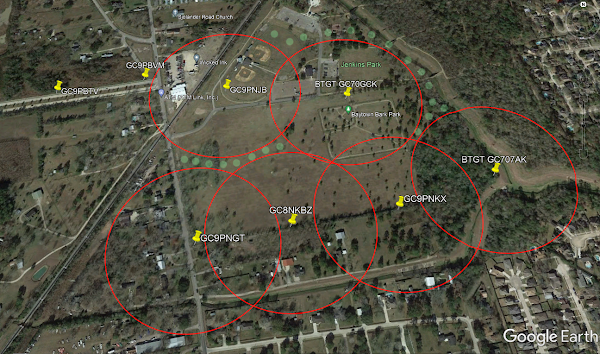How many times have you gone out caching with a full swag bag and a handful of trackables only to find nothing but micros, nanos, bison tubes, and DNA caches? Too many? Me too. Call me a grumpy old searcher if you like, but I am at the point where it is time to do something about it. How you ask? Well, by writing primers, teaching Geocaching 101 events (PCP8AB), and setting an example by hiding larger containers; that’s how.
At
the risk of sounding preachy, aren’t you also weary of how little thought has
been put into not only the container, but the location of so many caches these
days? Every time I see the description on a cache page that reads, “This corner
was just screaming for a cache, so I put one out!” I cringe. Arriving at the
precious location I read it is a muggle-heavy micro in a bush, with no hint and
possibly shaky coords. What? Again? The pharmacy parking lot is crowded with
cars and now I find myself on my hands and knees in front of some car’s grill
and the first thing I see is empty soda/pop bottles and McD’s wrappers that are
aged to nutty perfection. My thought is always, “Are no cachers doing CITO
these days” as the container has been published for 6 months.
I
check the D/T rating and it is a solid 1.5/1.5. After 20 minutes I leave and
feel like I’ve been cache-whipped. Checking the past logs I see someone with 18
finds praising the CO for hiding the smallest thing they’ve ever seen hold a
log. I shake my head and wonder if I will be back. The newbie swears it is an
“evil hide”, but I think it is a “stupid, needle in a haystack” hide as I
post a DNF.
The
only upside was the full sack of trash I picked up, as is my commitment to
giving back to the community. I carry a large container behind the seat of my
Jeep and a roll of trash bags and don’t feel bad about preaching CITO every
chance I get. CITO is the only beneficial thing we do for the community and so
many veterans appear to forget this, as evidenced by the many trash strewn
cache locations I’ve witnessed.
The
solution is twofold. Replace your containers with the largest container
possible to facilitate trackables and swag. You may have to actually get
creative so muggles don’t spot it, but cachers can make quicker work of logging
it and find the experience far superior to looking for a forgettable container.
I want to fool muggles, but unless I am deliberately trying to make it
difficult, I want cachers to find my hide. Give good hints. Cachers who don’t want
hints, won’t read it anyway, but a family with kids and us old folks will
appreciate it. Reserve evil hides for unique containers folks won’t recognize
rather than a nano glued to the bottom of a pebble in a rock pile by a gas
station. Come on! That is not evil folks; it is mean and most of us groan when
we find it.
Second,
archive that old LPC or micro that everyone has found (and has few, if any
favorite points) and place a new, better, and larger container. Do the homework
and make it something cool and awesome and folks will come and maybe give that
precious favorite point. Our landscape here in the Houston area is littered
with tiny insignificant hides and aren’t worth remembering for any reason
except to get a point. Many of the CO’s aren’t active or do maintenance on
their caches and in my opinion simply need to archive their hides. Open the
area back up for new better containers and let’s give this game a makeover. If
you hide caches, protect your user name by doing prompt maintenance. The last
thing you want to hear is your name dragged through the mud. Happy caching!





